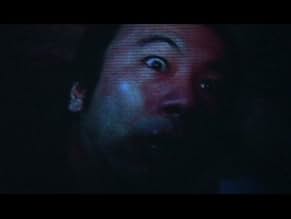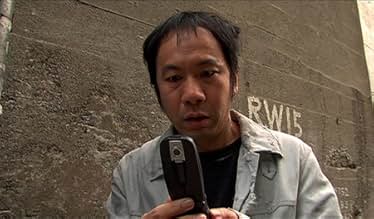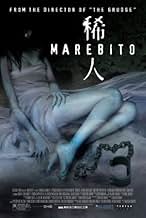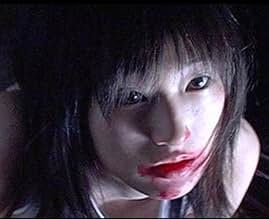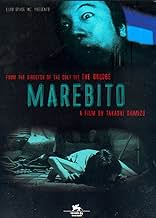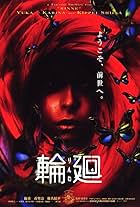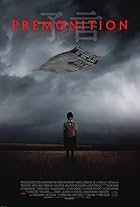IMDb RATING
6.0/10
5.8K
YOUR RATING
A fear-obsessed freelance cameraman (Shinya Tsukamoto) investigates an urban legend involving mysterious spirits that haunt the subways of Tokyo.A fear-obsessed freelance cameraman (Shinya Tsukamoto) investigates an urban legend involving mysterious spirits that haunt the subways of Tokyo.A fear-obsessed freelance cameraman (Shinya Tsukamoto) investigates an urban legend involving mysterious spirits that haunt the subways of Tokyo.
- Awards
- 1 win & 1 nomination
Storyline
Did you know
- TriviaTakashi Shimizu shot the film in just eight days, between the production dates for Ju-on: The Grudge (2002) and its remake, The Grudge (2004).
Featured review
First off, I hated Ju-On. I thought it was derivative garbage of the J-horror variety (most J-Horror, which many American's think is "cult", is the equivalent of teen slasher flicks in their respective countries). That said, I was expecting nothing from this film. Instead, I got a Japanese David Cronenberg film, for all intents and purposes. This film would make an excellent companion piece to Cronenberg's Videodrome.
Both deal with technology and alienation in an urban setting. While in Videodrome it's the proliferation of mass media that causes the protagonists reality slip, here it's the creation of such media. The main character is a freelance videographer who makes a living filming the horrible things that people do to each other (and themselves) in the crowded yet isolated world of the big city. He eventually comes to understand that nothing is more cruel than what he does. He is, in a figurative sense, a vampire. He sucks the blood of the living into his lens, and thrives off the rewards. But he is lost.
Then he meets...a girl? A creature? A vampire? A hallucination? The fact that she has no recognizable emotion or attachment, and lives only to feed on the blood of people is a projection of what he is so ashamed of.
This film really gets into the feel of alienation (much the way "Clean, Shaven" and Cronenberg's "Spider" did) and makes you feel the way the populace who views his videos do. Disturbed, but secretly glad and thrilled that misery was put on film.
Which leads me to the presentation. Many have griped about the Digital Film approach, which, as most cinephiles know, leads to a harsh lighting scheme and stark contrasts- none of the lushness of film- and jerky movement feel. Shimizou could have easily done this on film if he had wanted to, but instead, I feel, made a choice to use digital...it's the same format that his protagonist records horrible images on. One turn deserves another. I enjoyed this aspect, as the presentation aspect of a film is rarely intrinsic to both the style and subtext of the film.
That said, it's not entirely successful. A few scenes could have used better FX work or shot choice/editing, but, hey, he shot this on the fly in 8 days, on his way to make another J-Horror "scary-kid" schlockfest. This film shows he is more capable than that. Fans of J-horror may want to avoid this, whereas if, like me, you're a fan of shock-cinema and narrative surrealism (Lynch, some Cronenberg, you) may enjoy this.
Both deal with technology and alienation in an urban setting. While in Videodrome it's the proliferation of mass media that causes the protagonists reality slip, here it's the creation of such media. The main character is a freelance videographer who makes a living filming the horrible things that people do to each other (and themselves) in the crowded yet isolated world of the big city. He eventually comes to understand that nothing is more cruel than what he does. He is, in a figurative sense, a vampire. He sucks the blood of the living into his lens, and thrives off the rewards. But he is lost.
Then he meets...a girl? A creature? A vampire? A hallucination? The fact that she has no recognizable emotion or attachment, and lives only to feed on the blood of people is a projection of what he is so ashamed of.
This film really gets into the feel of alienation (much the way "Clean, Shaven" and Cronenberg's "Spider" did) and makes you feel the way the populace who views his videos do. Disturbed, but secretly glad and thrilled that misery was put on film.
Which leads me to the presentation. Many have griped about the Digital Film approach, which, as most cinephiles know, leads to a harsh lighting scheme and stark contrasts- none of the lushness of film- and jerky movement feel. Shimizou could have easily done this on film if he had wanted to, but instead, I feel, made a choice to use digital...it's the same format that his protagonist records horrible images on. One turn deserves another. I enjoyed this aspect, as the presentation aspect of a film is rarely intrinsic to both the style and subtext of the film.
That said, it's not entirely successful. A few scenes could have used better FX work or shot choice/editing, but, hey, he shot this on the fly in 8 days, on his way to make another J-Horror "scary-kid" schlockfest. This film shows he is more capable than that. Fans of J-horror may want to avoid this, whereas if, like me, you're a fan of shock-cinema and narrative surrealism (Lynch, some Cronenberg, you) may enjoy this.
- How long is Marebito?Powered by Alexa
Details
- Release date
- Country of origin
- Language
- Also known as
- The Stranger from Afar
- Production companies
- See more company credits at IMDbPro
Box office
- Budget
- ¥5,000,000 (estimated)
- Gross US & Canada
- $13,983
- Opening weekend US & Canada
- $3,852
- Dec 11, 2005
- Gross worldwide
- $107,259
- Runtime1 hour 32 minutes
- Color
- Aspect ratio
- 1.85 : 1
Contribute to this page
Suggest an edit or add missing content



